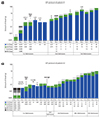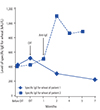Abstract
We reported a successful oral immunotherapy (OIT) in 2 children with high wheat sensitivity (4 and 14 years old boys). Oral challenges indicated eliciting doses of 300 mg, and wheat flour of 30 mg. The OIT protocol includes 5 days of build-up phase in the hospital, intervening with 2 to 5 months of home maintenance phase. Patients could tolerate 45 g, and 60 g of wheat flour per day, respectively. We have demonstrated that OIT to a large amount of wheat in extremely sensitized patients could be achieved with a stepwise multi oral/maintenance regimen.
Currently, the only accepted treatment for food allergy is a complete food avoidance until patients reach age which natural tolerance develops [1]. However, in wheat-sensitive patients, accidental exposure frequently occurs since wheat is commonly used in widely available processed foods. Moreover, age of natural tolerance to wheat is poorly defined [2]. In recent years, several pilot studies have shown that oral immunotherapy (OIT) could be a promising approach for the treatment of severe food allergy [3].
Rush protocols for OIT were successfully used for cow's milk, egg, and wheat allergy [4,5,6]. For wheat allergy, Fujino and Kurihara [6] conducted a rush OIT protocol in 2 Japanese children among whom could tolerate 5.6 g of wheat protein. However, they experienced several adverse reactions. We herein report a new multirush/maintenance wheat OIT regimen successfully employed among two extremely wheat sensitive patients.
Our first patient was a 4-year-old Thai boy who had several wheat anaphylaxis since 9 month of age. The episode involved swelling of eyes and mouth, dyspnea, and abdominal cramping 5 minutes after licked a piece of cake roll.
At 18 months of age, he had similar symptoms after eating a French toast (size, 0.5 cm), then was diagnosed as wheat allergy. Later, he had another anaphylactic episode after eating macaroni soup. The investigations were performed when he was 3 years of age. Specific immunoglobulin E (IgE) to wheat and ω-5 gliadin were 518 kAU/L and 37.8 kAU/L, respectively. He also had allergic to egg white (specific IgE, 15.5 kAU/L), but not allergic to cow's milk, soy, or peanut.
Due to the severe nature of the symptoms after repeated unintentional exposures, the parent requested OIT which was conducted after informed consent was obtained from his father.
The patient underwent oral wheat challenge in semi-intensive care unit. The challenge procedure started with 1 mg of wheat flour (Kite All-purpose flour, 100% wheat; UFM Food Centre Co., Bangkok, Thailand), that was mixed with tomato sauce (all ingredients had been tested to assure that the patient does not allergic to them). Anaphylaxis was elicited at the dose of 300 mg. On the next day, oral montelukast, intravenous chlorpheniramine, and ranitidine were given 1 hour prior to OIT as premedications. The OIT was started with 150 mg of wheat flour, was then doubled every 2 hours, 2 or 3 times per day. The protocol, adverse events, and treatments are shown in Fig. 1A. After 1 week, he was discharged with daily maintenance dose of wheat 500 mg for two months.
The total of 3 admissions for rush OIT protocol, intervening with maintenance period at home (2-5 months) was successful. The maintenance doses in each admission are shown in Table 1. He is currently taking 3 slices of bread (45 g of wheat flour) daily as maintenance dose at home, with urticaria once due to intake wheat more than the maintenance dose. His specific IgE to wheat and to ω-5-gliadin declined as shown in Fig. 2.
The second patient was a 14-year-old Thai boy who had his first wheat anaphylaxis episode at 4 months of age. After strict avoidance, he continued to have accidental exposures to wheat and developed repeated anaphylaxis about 1-2 episodes per year. The skin prick test was performed when he was 2 years of age, and showed positive result to wheat, but negative result to other food. His specific IgE to wheat and to ω-5 gliadin were 439 kAU/L, and 8.35 kAU/L, respectively. OIT was conducted after an informed consent was obtained from his parents.
The patient underwent double-blinded placebo controlled food challenge in semi-intensive care unit as in patient #1. The challenge procedure was started with 1 mg of wheat flour. The eliciting dose for anaphylaxis from wheat was 30 mg.
OIT was then started with a starting dose 8 mg with the same premedication as patent #1. The OIT protocol, adverse events, and treatment are shown in Fig. 1B. At the end of the first week, he was discharged and was maintained at 160 mg of wheat per day.
One week later, he developed an anaphylaxis at home. So, the maintenance dose was reduced to 80 mg per day, and 300 mg of anti-IgE (Xolair, Novartis, Basel, Switzerland) was given with repeated dose every 4 weeks. Three weeks after the first dose of anti-IgE, he was admitted and could tolerate 1,200 mg of wheat per day, within five days. The amount of wheat intake in each admission, specific IgE for wheat, and ω-5 gliadin were shown in Table 1 and Fig. 2. He is currently taking 60 g of wheat flour (4 slices of bread) per day without any symptoms. The anti-IgE was stopped after the 5th dose.
Since we were unsure of how our highly sensitive patients would respond to incremental doses of wheat, we chose to conduct a build-up phase within a semi-intensive hospital setting. This has proven to be a wise decision since anaphylaxis was observed at a very small amount of wheat (30 and 300 mg) with further episodes occurring during the build-up phase. With such experience, we chose to continue with several in-hospital rush periods for further build-up phase intervening with short home maintenance phase to adequately care for the patients during the build-up. Concurring with the experience from Fujino and Kurihara [6], less adverse events were observed with our protocol.
Omalizumab was shown to increase the threshold of sensitivity to peanuts [7] as well as facilitating rapid dose escalation in a pilot study with cow's milk OIT [8]. In our second patient, we demonstrated that omalizumab given only 3 weeks prior to increasing dose of wheat, also helped to increase the OIT dose.
The risks and benefits of OIT have to be carefully considered since the majority of wheat sensitized patient could outgrow their sensitivity even those with wheat specific IgE as high as 50 kAU/L [2]. The age of outgrowing as shown by Keet el al. [2] could be as late as 12 years of age. Our two patients are among the most extremely sensitized to wheat reported to date (with specific IgE for wheat levels at 518 and 439 kAU/L) and natural acquisition of tolerance would be unlikely, particularly in our patient #2 (14 years of age).
In this short report, we have demonstrated that OIT to a large amount of wheat could be achieved in a stepwise multi oral/maintenance regimen in extremely sensitized patients. Nonetheless, anaphylaxis is of concern. Apparently, a longer and perhaps safer wheat OIT protocol such as the one devised for egg [9] will need to be further established.
Figures and Tables
References
1. Sampson HA. Food allergy. Part 2: diagnosis and management. J Allergy Clin Immunol. 1999; 103:981–989.

2. Keet CA, Matsui EC, Dhillon G, Lenehan P, Paterakis M, Wood RA. The natural history of wheat allergy. Ann Allergy Asthma Immunol. 2009; 102:410–415.

4. Longo G, Barbi E, Berti I, Meneghetti R, Pittalis A, Ronfani L, Ventura A. Specific oral tolerance induction in children with very severe cow's milk-induced reactions. J Allergy Clin Immunol. 2008; 121:343–347.

5. García Rodríguez R, Urra JM, Feo-Brito F, Galindo PA, Borja J, Gomez E, Lara P, Guerra F. Oral rush desensitization to egg: efficacy and safety. Clin Exp Allergy. 2011; 41:1289–1296.

6. Fujino A, Kurihara K. Two cases of rush specific oral tolerance induction for wheat allergy. Arerugi. 2010; 59:1580–1584.
7. Leung DY, Sampson HA, Yunginger JW, Burks AW Jr, Schneider LC, Wortel CH, Davis FM, Hyun JD, Shanahan WR Jr. Avon Longitudinal Study of Parents and Children Study Team. Effect of anti-IgE therapy in patients with peanut allergy. N Engl J Med. 2003; 348:986–993.

8. Nadeau KC, Schneider LC, Hoyte L, Borras I, Umetsu DT. Rapid oral desensitization in combination with omalizumab therapy in patients with cow's milk allergy. J Allergy Clin Immunol. 2011; 127:1622–1624.

9. Burks AW, Jones SM, Wood RA, Fleischer DM, Sicherer SH, Lindblad RW, Stablein D, Henning AK, Vickery BP, Liu AH, Scurlock AM, Shreffler WG, Plaut M, Sampson HA. Consortium of Food Allergy Research (CoFAR). Oral immunotherapy for treatment of egg allergy in children. N Engl J Med. 2012; 367:233–243.





 PDF
PDF ePub
ePub Citation
Citation Print
Print





 XML Download
XML Download